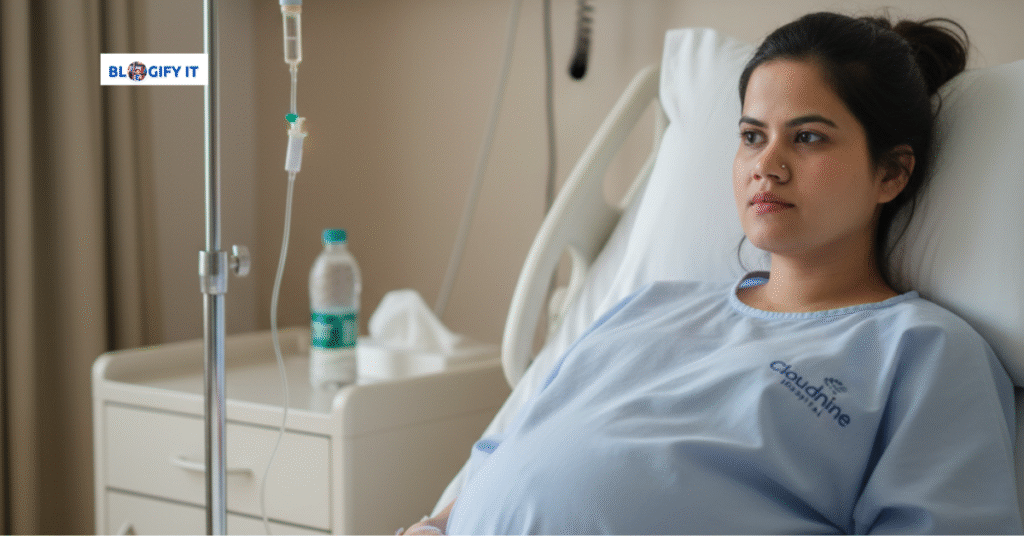If you’re pregnant and scanning the internet for “things to know before going into labor,” this is for you — the worried, excited, sometimes-overwhelmed expecting mother.
I’m writing this as a story: what actually happened to me, what I wish someone had told me, and small practical tips that made a huge difference. I’ll cover things to do before labour to make it easier, signs your body is getting ready for labour, pain-management techniques that helped me, and a few honest surprises.
Quick Tips: Pack light but well, arrange childcare (not just rely on your partner), learn a few breathing and counter-pressure moves, ask your provider about induction and eating rules, and don’t stress over “normal” vs C-section — what matters is a healthy you and baby.
Before Labour: Practical Things to do to Make it Easier
I still think about the little things I didn’t know before I went into labor. I was nervous, excited, and sometimes embarrassed to ask. If I could tell my past self one thing, it would be: these small preparations matter. I’m telling you what I learned — like a friend sharing tips over chai.
1. Shave Your Vagina Properly Before You Go to the Hospital
This one stuck with me. I assumed I could do it last minute or the nurses would help — but the truth is, it’s much easier if you do it properly at home a couple of days before you go in. Here’s what I’d tell you to do:
- Do it 2–3 days before your due date — that gives any small redness time to settle. Don’t try to do a perfect shave right before heading to the hospital.
- Trim first with small scissors or an electric trimmer if the hair is long — it makes shaving much safer.
- Take a warm shower to soften the skin and hair.
- Use a clean, fresh razor and a gentle shaving gel (not an old dull blade). If you’re worried about cuts, use an electric trimmer or ask a trusted salon/professional a few days earlier.
- Shave gently and slowly — short strokes, rinse the blade often. If the skin gets irritated or you nick yourself, stop and let it heal.
- Pat dry and use a mild, fragrance-free moisturizer or petroleum jelly if your skin feels raw.
- And if you feel uncomfortable doing it yourself, ask someone you trust or a professional — there’s no shame in that.
I wish I’d known to plan this — I had trouble bending and seeing clearly when I left it late. Doing it a few days earlier saved me stress.
2. Talk About Breastfeeding Before Labour
I wish I had talked to my doctor early about breastfeeding and made a clear plan before delivery. Most hospitals have lactation consultants who can help you learn how to latch your baby properly and guide you through the first feeding.
Don’t hesitate to ask for their help — it can make a big difference, especially if breastfeeding feels difficult at first. Also, try not to believe in common breastfeeding myths like “you won’t have enough milk in the beginning” or “you must feed on a strict schedule.” Every mom and baby are different, and early support really helps build your confidence.
3. Arrange Help Besides Your Partner
My partner was amazing, but both of us were exhausted. If possible, line up a family member, friend, or postpartum helper to stay for at least the first few days. You’ll need someone to hold the baby while you rest, make tea, or simply help with small things.
4. Pain Management — Learn a Few Techniques Beforehand
Pain is real and it’s okay to ask for help. For me, breathing and changing positions helped early on. Warm showers, massage, and simple movement can ease things. If you want an epidural or other medical pain relief, talk about options with your doctor beforehand — and know it’s okay to use them.
5. They Might Put a Belt on Your Tummy — it Can Feel Uncomfortable
During labor the nurses placed a monitor belt on my belly to check the baby’s heartbeat. It felt tight and annoying during contractions. It’s normal and necessary, but I wish someone had warned me so I wouldn’t be surprised by how it felt.
6. Delivering the Baby isn’t the Very End — there’s the Placenta Too
After the baby is born, you’ll still need to deliver the placenta. It may feel like a few more contractions or a little pushing. It’s part of the process — not scary, just another step to know about.
7. Don’t Stress About Having a “Normal” Delivery Only
I felt pressure to have a vaginal birth because that’s what everyone talked about. I did some exercises also to maximize the chances of my vaginal delivery. However, I was never adamant about it. But if you need a C-section or other intervention, that’s okay. The goal is a safe outcome for you and your baby — not meeting someone else’s idea of “normal.”
8. Pack the Hospital Bag — But Prioritise Comfort and Essentials
Don’t overpack baby outfits you’ve been dreaming about; hospitals provide basics. Pack things that helped me sleep and feel human:
- Comfortable clothes (nightie, loose top, socks)
- Big underwear and maternity pads
- Your pillow or a pillowcase (smells like home)
- Snacks, electrolyte drinks, chapstick, hair ties
- Phone charger, headphones, and a small mirror
- Copies of your birth plan, ID, and insurance papers
Also include a few little items for recovery and breastfeeding (nipple cream, nursing bras, pads). Midwives and hospitals often have supplies but having your own comfort items really helped me relax.
Signs Your Body is Getting Ready for Labour (and what they actually mean)

Knowing the common signs takes the panic out of the moment:
- Contractions that get regular, longer and stronger — the main sign labour is progressing.
- “Show” (mucus plug) — a jelly-like, sometimes blood-tinged discharge; labour might be hours to days away.
- Your waters breaking — could be a gush or a trickle; let your midwife know.
- Backache, pelvic pressure, needing the loo more often.
- “Lightening” — baby drops lower into the pelvis (usually in first pregnancies).
If you notice these signs and are unsure what to do, contact your midwife or maternity unit — they’ll guide next steps.
My Induction Experience (the prostaglandin “gel”)
I didn’t go into labour naturally. At the hospital they used a small prostaglandin gel (often called dinoprostone or “prostin” in some places) placed in the vagina to help ripen my cervix.
It’s a very common, safe method used when induction is medically recommended; it can be repeated and sometimes takes several hours (or longer) to work. If your cervix is slow to dilate, your team may recommend this — it’s not a painful injection, just a local gel applied internally.
A practical tip from my induction: if your hospital allows it, have a proper meal before you go in. I learned this the hard way — induction can sometimes take 12 to 24 hours, and you’ll need energy to stay comfortable and get through it. Eating beforehand saved me from feeling weak or dizzy while waiting for labor to progress, and it gave me one less thing to stress about. This brings us to our next section.
Eating During Labour — What’s Allowed?
This confused me more than it should have. Historically, people were told not to eat in labour because of anesthesia risks; today guidance is more nuanced. Many experts now support limited oral intake (clear fluids, electrolyte drinks; some centers allow light snacks) for low-risk labor. While solid food is often discouraged in active labour, always check your hospital’s policy and your provider’s advice before assuming you can eat freely.
The Belt on Your Tummy — Why They Strap You in and How to Cope
That uncomfortable “belt” I mentioned is usually the external monitor used to track fetal heart rate and contractions. It can feel awkward — especially when you want to change position — but it’s there to reassure staff that the baby is doing well.
If it’s painful or you need to move, tell your midwife: they’ll re-position the monitor or allow intermittent monitoring when it’s safe. Continuous monitoring is helpful in some situations, but it’s not always required for low-risk labours.
Pain Management During Labour — What Actually Helped Me
I went into labor planning for an unmedicated birth, but I stayed open to other options. Looking back, here’s what really helped me, and what I’d suggest trying during the last weeks of pregnancy so you feel ready and confident:
1. Moving and Changing Positions
Walking around, swaying, sitting on a birth ball, or just shifting positions made contractions feel less strong. Even small movements helped me feel more in control.
2. Heat Packs and Counter-pressure
During back labor, heat packs on my lower back were a lifesaver. Having someone press gently on my lower back at the right moments (counter-pressure) made a huge difference. I couldn’t have done it alone — my birth partner’s help was invaluable.
3. Breathing and Relaxation
I practiced simple breathing exercises ahead of time. Slow, deep breaths helped me stay calm, and the “pant-pant-blow” technique worked during pushing. Breathing gives you a sense of control and helps your birth partner know how to support you.
4. Epidural and Other Medications
If the pain feels too much, an epidural can be very effective — it’s commonly offered in hospitals. There are also pain injections like pethidine and even TENS machines. Each option has its pros and cons, so it helps to talk with your doctor beforehand. I found that sometimes a mix of breathing, movement, and medication worked best.
Check Baby for Jaundice — Don’t Skip This
Newborn jaundice is common. Hospitals routinely check newborns for jaundice in the first 24–48 hours and may measure bilirubin levels if there’s early yellowing. If it appears in the first 24 hours, it needs prompt evaluation. Ask the newborn team for details before discharge — and follow up if the baby looks yellow at home.
Final Thoughts — and one last piece of advice
So, here were some things I wish I knew before going into labor. If I could whisper one thing to my pregnant self on the first night of contractions, it’d be: you are allowed to be vulnerable, to change your mind, and to ask for help. Labour is a shared, medical, and human event — knowledge helps, but support matters more. Pack what comforts you, arrange help for the rest of life at home, and bring curiosity (not rigid expectations) to your birth.
Important note: This post is based on my experience and on standard guidance from trusted sources (NHS, ACOG/ASA statements, AAP/HealthyChildren, La Leche League). It does not replace personalised medical advice. Always talk with your midwife, obstetrician, or healthcare team about what’s right for you.




